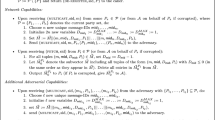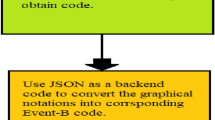Abstract
Almost 50 years ago, D. E. Bell and L. LaPadula published the first formal model of a secure system, known today as the Bell–LaPadula (BLP) model. BLP is described as a state machine by means of first-order logic and set theory. The authors also formalize two state invariants known as security condition and *-property. Bell and LaPadula prove that all the state transitions preserve these invariants. In this paper we present a fully automated proof of the security condition and the *-property for all the model operations. The model and the proofs are coded in the \(\{log\}\) tool. As far as we know this is the first time such proofs are automated. Besides, we show that the \(\{log\}\) model is also an executable prototype. Therefore we are providing an automatically verified executable prototype of BLP.
Similar content being viewed by others
Notes
This number is obtained on a Latitude E7470 (06DC) with a 4 core Intel(R) Core™ i7-6600U CPU at 2.60GHz with 8 Gb of main memory. The software components are the following: Linux Ubuntu 18.04.3 (LTS) 64-bit with kernel 4.15.0-70-generic, and \(\{log\}\) 4.9.6-18b over SWI-Prolog (multi-threaded, 64 bits, version 7.6.4).
References
Abrial, J.R.: The B-Book: Assigning Programs to Meanings. Cambridge University Press, New York (1996)
Anderson, J.P.: Computer security technology planning study. Techreport ESD-TR-73-51, Vol II, Deputy for Command and Management Systems, HQ Electronic Systems Division (AFSC) (1972). http://seclab.cs.ucdavis.edu/projects/history/papers/ande72.pdf
Barthe, G., Betarte, G., Campo, J.D., Luna, C.: System-level non-interference of constant-time cryptography. Part I: model. J. Autom. Reason. 63(1), 1–51 (2019). https://doi.org/10.1007/s10817-017-9441-5
Barthe, G., Grégoire, B., Heraud, S., Olmedo, F., Béguelin, S.Z.: Verified indifferentiable hashing into elliptic curves. J. Comput. Secur. 21(6), 881–917 (2013). https://doi.org/10.3233/JCS-130476
Basin, D.A., Cremers, C., Meadows, C.A.: Model checking security protocols. In: Clarke, E.M., Henzinger, T.A., Veith, H., Bloem, R. (eds.) Handbook of Model Checking, pp. 727–762. Springer, Berlin (2018). https://doi.org/10.1007/978-3-319-10575-8_22
Bell, D.E., LaPadula, L.: Secure Computer Systems: Mathematical Foundations. MTR 2547, The MITRE Corporation, McLean (1973)
Bell, D.E., LaPadula, L.: Secure Computer Systems: Mathematical Model. ESD-TR 73-278, The MITRE Corporation, McLean (1973)
Bonichon, R., Delahaye, D., Doligez, D.: Zenon: an extensible automated theorem prover producing checkable proofs. In: Dershowitz, N., Voronkov, A. (eds.) 14th International Conference on Logic for Programming, Artificial Intelligence, and Reasoning, LPAR 2007, Yerevan, Armenia, October 15–19, 2007, Proceedings. Lecture Notes in Computer Science, vol. 4790, pp. 151–165. Springer (2007). https://doi.org/10.1007/978-3-540-75560-9_13
Coq Development Team: The Coq Proof Assistant Reference Manual, Version 8.8.1. LogiCal Project, Palaiseau, France (2018)
Cristiá, M.: Formal verification of an extension of a secure, compatible UNIX file system. In: Anales de la XXIX Conferencia Latinoamericana de Informática. CLEI, La Paz, Bolivia (2003)
Cristiá, M., Rossi, G.: A decision procedure for restricted intensional sets. In: de Moura, L. (ed.) Automated Deduction—CADE 26—26th International Conference on Automated Deduction, Gothenburg, Sweden, August 6–11, 2017, Proceedings. Lecture Notes in Computer Science, vol. 10395, pp. 185–201. Springer (2017). https://doi.org/10.1007/978-3-319-63046-5_12
Cristiá, M., Rossi, G.: A set solver for finite set relation algebra. In: Desharnais, J., Guttmann, W., Joosten, S. (eds.) Relational and Algebraic Methods in Computer Science—17th International Conference, RAMiCS 2018, Groningen, The Netherlands, October 29–November 1, 2018, Proceedings. Lecture Notes in Computer Science, vol. 11194, pp. 333–349. Springer (2018). https://doi.org/10.1007/978-3-030-02149-8_20
Cristiá, M., Rossi, G.: Automated reasoning with restricted intensional sets (2019). CoRR arXiv:1910.09118
Cristiá, M., Rossi, G.: Solving quantifier-free first-order constraints over finite sets and binary relations. J. Autom. Reason. 64(2), 295–330 (2020). https://doi.org/10.1007/s10817-019-09520-4
Cristiá, M., Rossi, G., Frydman, C.S.: log as a test case generator for the Test Template Framework. In: Hierons, R.M., Merayo, M.G., Bravetti, M. (eds.) SEFM. Lecture Notes in Computer Science, vol. 8137, pp. 229–243. Springer, Berlin (2013)
Dénès, M., Hritcu, C., Lampropoulos, L., Paraskevopoulou, Z., Pierce, B.C.: Quickchick: property-based testing for Coq. In: The Coq Workshop (2014)
Devyanin, P.N., Khoroshilov, A.V., Kuliamin, V.V., Petrenko, A.K., Shchepetkov, I.V.: Formal verification of OS security model with alloy and event-b. In: Ameur, Y.A., Schewe, K. (eds.) Abstract State Machines, Alloy, B, TLA, VDM, and Z—4th International Conference, ABZ 2014, Toulouse, France, June 2–6, 2014. Proceedings. Lecture Notes in Computer Science, vol. 8477, pp. 309–313. Springer (2014). https://doi.org/10.1007/978-3-662-43652-3_30
Doligez, D., Jaume, M., Rioboo, R.: Development of secured systems by mixing programs, specifications and proofs in an object-oriented programming environment: a case study within the focalize environment. In: Maffeis, S., Rezk, T. (eds.) Proceedings of the 2012 Workshop on Programming Languages and Analysis for Security, PLAS 2012, Beijing, China, 15 June, 2012, p. 9. ACM (2012). https://doi.org/10.1145/2336717.2336726
Dovier, A., Piazza, C., Pontelli, E., Rossi, G.: Sets and constraint logic programming. ACM Trans. Program. Lang. Syst. 22(5), 861–931 (2000)
Dovier, A., Pontelli, E., Rossi, G.: Set unification. Theory Pract. Log Program. 6(6), 645–701 (2006). https://doi.org/10.1017/S1471068406002730
Gasser, M.: Building a Secure Computer System. Van Nostrand Reinhold Co., New York (1988)
Goguen, J.A., Meseguer, J.: Security policies and security models. In: 1982 IEEE Symposium on Security and Privacy, Oakland, CA, USA, April 26–28, 1982, pp. 11–20. IEEE Computer Society (1982). https://doi.org/10.1109/SP.1982.10014
Haraty, R.A., Naous, M.: Role-based access control modeling and validation. In: 2013 IEEE Symposium on Computers and Communications, ISCC 2013, Split, Croatia, 7–10 July, 2013, pp. 61–66. IEEE Computer Society (2013). https://doi.org/10.1109/ISCC.2013.6754925
Lipner, S.B.: The birth and death of the orange book. IEEE Ann. Hist. Comput. 37(2), 19–31 (2015). https://doi.org/10.1109/MAHC.2015.27
McLean, J.: A comment on the ’basic security theorem’ of bell and lapadula. Inf. Process. Lett. 20(2), 67–70 (1985). https://doi.org/10.1016/0020-0190(85)90065-1
McLean, J.: Twenty years of formal methods. In: 1999 IEEE Symposium on Security and Privacy, Oakland, California, USA, May 9–12, 1999, pp. 115–116. IEEE Computer Society (1999). https://doi.org/10.1109/SECPRI.1999.766907
Murray, T.C., Matichuk, D., Brassil, M., Gammie, P., Bourke, T., Seefried, S., Lewis, C., Gao, X., Klein, G.: sel4: From general purpose to a proof of information flow enforcement. In: 2013 IEEE Symposium on Security and Privacy, SP 2013, Berkeley, CA, USA, May 19–22, 2013, pp. 415–429. IEEE Computer Society (2013). https://doi.org/10.1109/SP.2013.35
Nipkow, T., Paulson, L.C., Wenzel, M.: Isabelle/HOL—A Proof Assistant for Higher-Order Logic, Lecture Notes in Computer Science, vol. 2283. Springer (2002). https://doi.org/10.1007/3-540-45949-9
Rossi, G.: \(\{log\}\) (2008). http://people.dmi.unipr.it/gianfranco.rossi/setlog.Home.html
Sabelfeld, A., Myers, A.C.: Language-based information-flow security. IEEE J. Sel. A. Commun. 21(1), 5–19 (2006). https://doi.org/10.1109/JSAC.2002.806121
Schwartz, J.T., Dewar, R.B.K., Dubinsky, E., Schonberg, E.: Programming with Sets—An Introduction to SETL. Texts and Monographs in Computer Science. Springer, Berlin (1986). https://doi.org/10.1007/978-1-4613-9575-1
Spivey, J.M.: The Z Notation: A Reference Manual. Prentice Hall International (UK) Ltd., Hertfordshire (1992)
Stasiak, A., Zielinski, Z.: An approach to automated verification of multi-level security system models. In: Zamojski, W., Mazurkiewicz, J., Sugier, J., Walkowiak, T., Kacprzyk, J. (eds.) New Results in Dependability and Computer Systems—Proceedings of the 8th International Conference on Dependability and Complex Systems DepCoS-RELCOMEX, September 9–13, 2013, Brunów, Poland. Advances in Intelligent Systems and Computing, vol. 224, pp. 375–388. Springer (2013). https://doi.org/10.1007/978-3-319-00945-2_34
von Oheimb, D.: Information flow control revisited: Noninfluence = noninterference + nonleakage. In: Samarati, P., Ryan, P.Y.A., Gollmann, D., Molva, R. (eds.) 9th European Symposium on Research Computer Security—ESORICS 2004, Sophia Antipolis, France, September 13–15, 2004, Proceedings. Lecture Notes in Computer Science, vol. 3193, pp. 225–243. Springer (2004). https://doi.org/10.1007/978-3-540-30108-0_14
Author information
Authors and Affiliations
Corresponding author
Additional information
Publisher's Note
Springer Nature remains neutral with regard to jurisdictional claims in published maps and institutional affiliations.
Rights and permissions
About this article
Cite this article
Cristiá, M., Rossi, G. Automated Proof of Bell–LaPadula Security Properties. J Autom Reasoning 65, 463–478 (2021). https://doi.org/10.1007/s10817-020-09577-6
Received:
Accepted:
Published:
Issue Date:
DOI: https://doi.org/10.1007/s10817-020-09577-6




